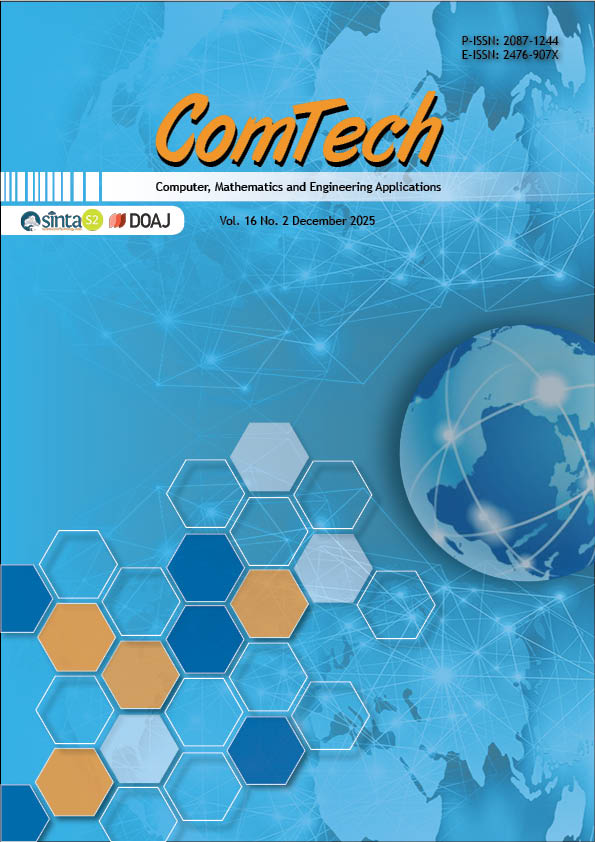Temperature Forecast at Djuanda International Airport using ARIMA, ANN, and Hybrid ARIMA-ANN
DOI:
https://doi.org/10.21512/comtech.v16i2.13219Keywords:
Artificial Neural Network (ANN) model, forecasting, weather, SurabayaAbstract
This research evaluates the performance of Artificial Neural Network (ANN) models in forecasting temperature at Djuanda Airport, comparing them with the traditional Autoregressive Integrated Moving Average (ARIMA) model and a hybrid ARIMA–ANN approach. Although statistical models such as ARIMA are widely applied, their capacity to capture nonlinear dynamics in tropical climate conditions is limited, particularly when the data exhibit irregular fluctuations that linear models cannot adequately represent. Forecasting temperatures in tropical airport settings, which is crucial for flight planning, operational safety, and the reliability of aviation operations, remains relatively underexplored. This gap underscores the importance of alternative modeling techniques that can effectively address nonlinear relationships. Using one year of observed data, the models are evaluated with three accuracy metrics: Mean Absolute Error (MAE), Mean Absolute Percentage Error (MAPE), and Root Mean Squared Error (RMSE). The ANN model achieves the lowest error values (MAE 0.7630, MAPE 2.7067%, RMSE 1.0074) compared to both ARIMA and hybrid approaches. The metrics and the testing graph collectively indicate that ANN has a stronger ability to capture nonlinear temperature dynamics in tropical contexts. Nonetheless, the findings must be interpreted with caution due to the limited dataset and single case study. These limitations highlight the need for extended data and alternative architectures to improve forecasting accuracy and strengthen support for safer aviation operations.
References
Amaly, M. H., Hirzi, R. H., & Basirun. (2022). Perbandingan metode ANN backpropagation dan ARMA untuk peramalan inflasi di Indonesia. Jambura Journal of Probability and Statistics, 3(2), 61–70. https://doi.org/https://doi.org/10.34312/jjps.v1i1.15440
Aruan, N. M., Panggabean, D. A. H., & Sihombing, F. M. (2021). Prediksi tinggi curah hujan dan kecepatan angin berdasarkan data cuaca dengan penerapan algoritma Artificial Neural Network (ANN). SEMINASTIKA, 3(1), 1–7. https://doi.org/10.47002/seminastika.v3i1.237
Bączkiewicz, A., Wątróbski, J., Sałabun, W., & Kołodziejczyk, J. (2021). An ANN model trained on regional data in the prediction of particular weather conditions. Applied Sciences (Switzerland), 11(11), 4757. https://doi.org/10.3390/app11114757
Chandra, R., Chaudhary, K., & Kumar, A. (2022). Comparison of data normalization for wine classification using K-NN algorithm. IJIIS: International Journal of Informatics and Information Systems, 5(4), 175–180. https://doi.org/10.47738/ijiis.v5i4.145
Geurts, M., Box, G. E. P., & Jenkins, G. M. (1970). Time series analysis: Forecasting and control Holden-Day series in time series analysis and digital processing. In Holden Day. https://doi.org/10.2307/3150485
Guobadia, E. K., & Uadiale, K. K. (2024). Effect of Box-Cox transformation on a k-th weighted moving average processes for time series. African Multidisciplinary Journal of Sciences and Artificial Intelligence, 1(1), 655–668. https://doi.org/https://doi.org/10.58578/AMJSAI.v1i1.3755
Hilal, Y. N., Nainggolan, G. D. A., Syahputri, S. H., & Kartiasih, F. (2024). Comparison of ARIMA and LSTM methods in predicting Jakarta sea level. Jurnal Ilmu Dan Teknologi Kelautan Tropis, 16(2), 163–178. https://doi.org/10.29244/jitkt.v16i2.52818
Ihsan, H., Irwan, I., & Nensi, A. I. E. (2024). Implementation of backpropagation and hybrid ARIMA-NN methods in predicting accuracy levels of rainfall in Makassar city. BAREKENG: Jurnal Ilmu Matematika Dan Terapan, 18(4), 2435–2448. https://doi.org/10.30598/barekengvol18iss4pp2435-2448
Kania, D. D. (2022). Sektor penerbangan global dalam isu perubahan iklim : Dampak dan mitigasinya. Jurnal Manajemen Transportasi & Logistik (JMTRANSLOG), 8(2), 133. https://doi.org/10.54324/j.mtl.v8i2.713
Katabba, Y. I., & Estefani, K. (2023). Penerapan model Self-Exciting Threshold Autoregressive (SETAR) nonlinear dalam memodelkan data harga minyak sawit (FCPOc1). Mathematical Sciences and Applications Journal, 4(1), 33–39. https://doi.org/10.22437/msa.v4i1.28292
Laily, V. O. N., Suhartono, Pusporani, E., & Atok, R. M. (2021). A novel hybrid MGSTAR-RNN model for forecasting spatio-temporal data. Journal of Physics: Conference Series, 1752(1), 012011. https://doi.org/10.1088/1742-6596/1752/1/012011
Leontinus, G. (2022). Program dalam pelaksanaan tujuan pembangunan berkelanjutan (SDGs) dalam hal masalah perubahan iklim di Indonesia. Jurnal Samudra Geografi, 5(1), 43–52. https://doi.org/10.33059/jsg.v5i1.4652
Maulana, C., & Hajarisman, N. (2023). Penerapan transformasi Box Cox untuk mengatasi masalah ketidakstasioneran dan pola periodik dalam data deret waktu pada ekspor bidang pertanian di Indonesia. Bandung Conference Series: Statistics, 3(2), 763–772. https://doi.org/10.29313/bcss.v3i2.9371
Montgomery, D. C., Jennings, C. L., & Murat, K. (2015). Introduction to time series analysis and forecasting. John Wiley & Sons.
Muslihin, K. R. A., & Ruchjana, B. N. (2023). Model Autoregressive Moving Average (ARMA) untuk peramalan tingkat inflasi di Indonesia. Limits: Journal of Mathematics and Its Applications, 20(2), 209. https://doi.org/10.12962/limits.v20i2.15098
Nanlohy, Y. W. A., & Loklomin, S. B. (2023). Model Autoregressive Integrated Moving Average (ARIMA) untuk meramalkan inflasi Indonesia. VARIANCE: Journal of Statistics and Its Applications, 5(2), 201–208. https://doi.org/10.30598/variancevol5iss2page201-208
NOAA. (2024). Climate data records. National Oceanic and Atmospheric Administration. https://www.ncei.noaa.gov/cdo-web/
Novita, R., & Putri, A. (2021). Analisis algoritma backpropagation Neural Network dalam permalan jumlah benih ikan. Jurnal Ilmiah Rekayasa Dan Manajemen Sistem Informasi, 7(2), 201–207.
Palupi, S. P., Sadik, K., & Afendi, F. M. (2023). Perbandingan performa metode hybrid ARIMA-SVM dan ARIMA-NNAR pada peramalan data deret waktu [IPB University]. http://repository.ipb.ac.id/handle/123456789/123662
Pangaribuan, J. J., Fanny, F., Barus, O. P., & Romindo, R. (2023). Prediksi penjualan bisnis rumah properti dengan menggunakan metode Autoregressive Integrated Moving Average (ARIMA). Jurnal Sistem Informasi Bisnis, 13(2), 154–161. https://doi.org/10.21456/vol13iss2pp154-161
Pradana, D. A. P., Mahananto, F., & Djunaidy, A. (2022). Sistem peramalan menggunakan Autoregressive Integrated Moving Average with Exogenous Variables (ARIMAX) untuk harga minyak sawit Indonesia. Jurnal Teknik ITS, 11(2). https://doi.org/10.12962/j23373539.v11i2.86373
Razzaaq, M., Lubis, L. H., & Sirait, R. (2024). Studi pengaruh suhu dan tekanan udara terhadap gaya angkat pesawat tahun 2014-2021 di Bandara Internasional Kualanamu Deli Serdang. Relativitas: Jurnal Riset Inovasi Pembelajaran Fisika, 7(2), 102–111. https://doi.org/10.29103/relativitas.v7i2.18923
Sakti, A. I., Saputra, L., Suhendra, H., Halim, N., Alviari, I., Ilham, M. R. N., Putri, M. H. N., & Dalimunthe, D. Y. (2024). Implementasi Artificial Neural Network (ANN) dalam memprediksi nilai tukar Rupiah terhadap Dolar Amerika. Euler : Jurnal Ilmiah Matematika, Sains Dan Teknologi, 12(2), 124–130. https://doi.org/10.37905/euler.v12i2.26654
Saputra, R., Sunardiyo, S., Nugroho, A., & SUbiyanto. (2023). Analisis arsitektur jaringan syaraf tiruan-multilayer perceptron untuk efektivitas estimasi beban energi listrik PT. PLN (Persero) UP3 Salatiga. ELKOMIKA: Jurnal Teknik Energi Elektrik, Teknik Telekomunikasi, & Teknik Elektronika, 11(3), 664. https://doi.org/10.26760/elkomika.v11i3.664
Schmidgall, S., Ziaei, R., Achterberg, J., Kirsch, L., Hajiseyedrazi, S. P., & Eshraghian, J. (2024). Brain-inspired learning in artificial neural networks: A review. APL Machine Learning, 2(2), 1–13. https://doi.org/10.1063/5.0186054
Ulandari, R. (2023). Perbandingan metode Autoregressive Integrated Moving Average dengan metode hybrid Autoregressive Integrated Moving Average Jaringan Saraf Tiruan pada peramalan harga emas. Universitas Hasanuddin.
Wicaksono, A. (2024). Anomali suhu udara bulan Oktober 2024. Badan Meteorologi, Klimatologi, Dan Geofisika. https://www.bmkg.go.id/iklim/anomali-suhu-udara/anomali-suhu-udara-bulan-oktober-2024
Downloads
Published
How to Cite
Issue
Section
License
Copyright (c) 2025 Elly Pusporani, Fitriana Nur Afifa, Fidela Sahda Ilona Ramadhina

This work is licensed under a Creative Commons Attribution-ShareAlike 4.0 International License.
Authors who publish with this journal agree to the following terms:
a. Authors retain copyright and grant the journal right of first publication with the work simultaneously licensed under a Creative Commons Attribution License - Share Alike that allows others to share the work with an acknowledgment of the work's authorship and initial publication in this journal.
b. Authors are able to enter into separate, additional contractual arrangements for the non-exclusive distribution of the journal's published version of the work (e.g., post it to an institutional repository or publish it in a book), with an acknowledgment of its initial publication in this journal.
c. Authors are permitted and encouraged to post their work online (e.g., in institutional repositories or on their website) prior to and during the submission process, as it can lead to productive exchanges, as well as earlier and greater citation of published work.
 USER RIGHTS
 All articles published Open Access will be immediately and permanently free for everyone to read and download. We are continuously working with our author communities to select the best choice of license options, currently being defined for this journal as follows:




















